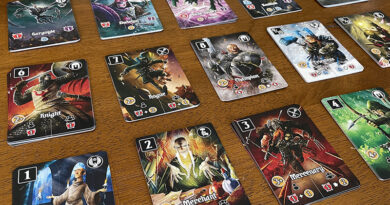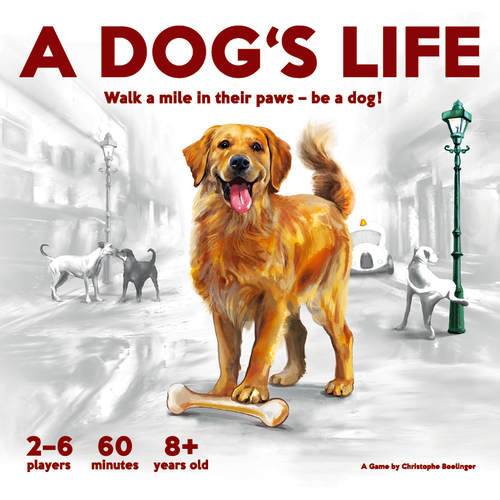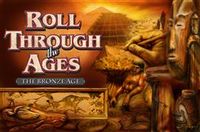Shadows: Amsterdam could be Zootopia the board game
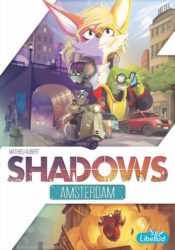
A crime has been committed, but the police investigation is going nowhere. An anonymous client has called your detective agency to investigate. However, your rivals are on the case as well, so there’s no time to waste.
Your Intelligence Officer will guide your Detectives through the city, by sending pictures to communicate. Each image contains location intel … for those who can understand. But you need to decode the messages faster than your rivals while avoiding the police! Explore the city to find three pieces of evidence, and deliver them to your client before the other team in order to receive payment — and win the game!
Shadows: Amsterdam, by Libellud and Asmodee, is a real-time, simultaneous deduction game played in teams. It’s full of colorful artwork, obscure clues, frantic racing, and lots of fun.
It also reminds us a lot of the movie Zootopia!
Just like in the movie, you’re trying to solve a crime by following clues all over colorful locations. The great thing is that you’re not alone. Work together with your teammates to make your way around the city to solve the case!
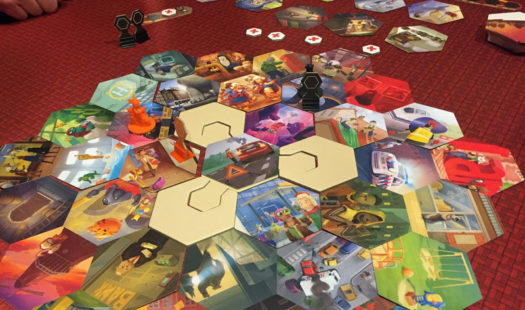
How to play Shadows: Amsterdam
In Shadows: Amsterdam players divide up into 2 teams and, in real-time, race to be the first team to find 3 Evidence Locations and then get to a final Client checkpoint.
To set up, players construct the game board using the double-sided tiles. They’re placed randomly around the central starting tile and the two Detective figures (orange and black) are set out on the central space.
Teams decide which player on their team will be the Intelligence Officer (clue giver) and the rest will be the Detectives. Intelligence Officers for both teams sit next to each other on one side of the table while the Detectives sit on the opposite side. The Intelligence Officers set out their screens and select the map cards they’ll use for the game. There are 2 of each map diagram – one with a black border and one with an orange border. The Intelligence Officers orient their map cards the same way and so it corresponds with the constructed game board.
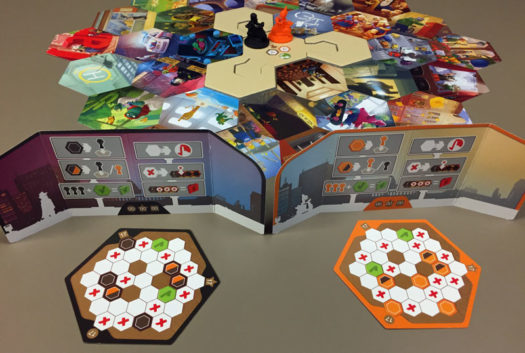
Each map card shows a number of elements. There are various Evidence locations they need to direct their teammates to move to. Some are only available to one team while others can be reached by either team (show both black and orange). The 2 green spaces are the possible final Client locations a team needs to move to in order to win the game. Spaces with an X are the cops and teams will get a strike if they end a movement on one of these spaces. (Because the cops don’t want these Detectives messing with their own investigation.)
Lastly, the Intel cards are shuffled and 10 are placed out face up on the table.
Once players are ready, the game begins.
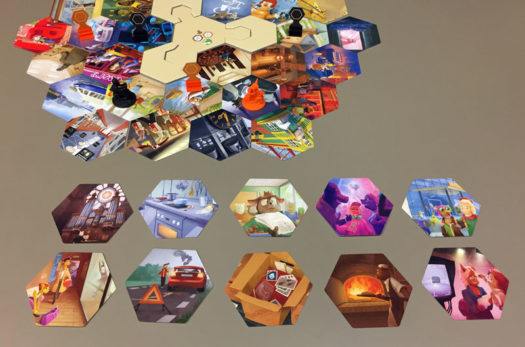
There isn’t any taking turns in Shadows: Amsterdam. Instead, play is in real-time with teams going as fast as they can to get to collect 3 pieces of evidence and get to their client.
To get their team to move, an Intelligence Officer selects 1 or 2 Intel cards from those face up and hands them to their teammates. If they give 1 card to their team, it indicates they must move 1 space. If they give 2 cards, it means they must move exactly 2 spaces from their current location. New Intel cards are drawn to replace those used.
Teammates receiving the cards then discuss what their team’s Intelligence Officer is trying to convey through the imagery on the cards. Once they think they know where their Intelligence Officer is trying to get them to move, they move their Detective piece to that location.
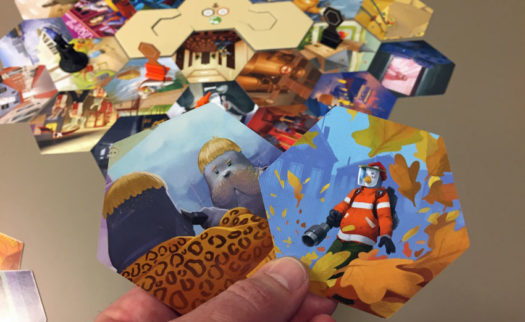
If they end on a space that is one of their possible Evidence spaces, the Intelligence Officer places one of their team’s color Evidence marker on the space. If they end their turn on a cop space, the Intelligence Officer places an X token on their team’s cop tile – showing their strikes against them. If they end on any other space (as displayed on the Intelligence Officer’s map), nothing happens.
Play continues with the Intelligence Officer handing out Intel cards and Detectives moving their detective piece around the board.
If the team has placed their 3 Evidence markers on the board and then ends their move on one of the final Client spaces, that team wins the round.
And the first team to successfully win 2 rounds, wins the game!
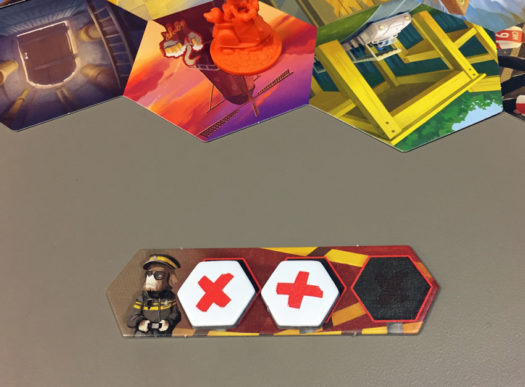
Can the whole family enjoy Shadows: Amsterdam?
Just like the movie Zootopia, Shadows: Amsterdam can be enjoyed by players of all ages for a number of reasons.
For starters, the game is played in teams. And that makes it a fantastic game for both older and younger players alike because they can team up in any number of ways. You can mix ages on teams or even play young vs old if you’d like.
As long as the clue giver can understand how their map card corresponds to the board spaces, they’re set. As far as the other teammates go, there isn’t really any age restriction. They only need to interpret visual clues to move their playing piece.
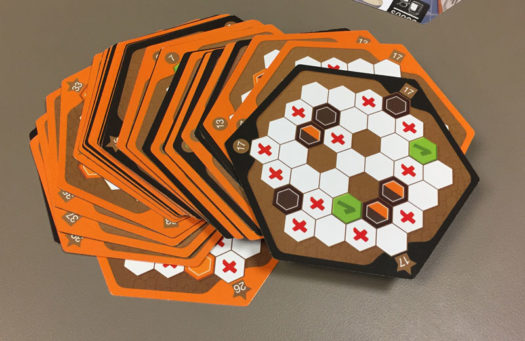
Of course, I shouldn’t say “only” because interpreting the clues can be tricky itself. The images will most always be vague references and players will have to deduce what the clue giver is trying to say. But that’s also where the fun in the game comes from!
Can you get on the same wavelength as your Intelligence Officer?
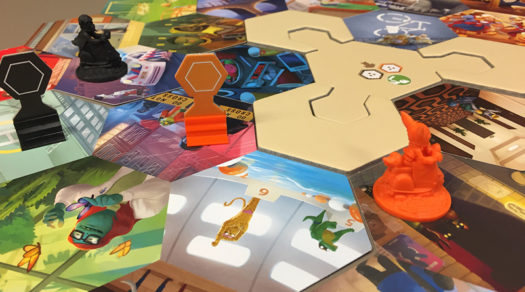
This also leads to the next reason the game can be played by players of any age — there isn’t any text to read. Even the reminders on the Intelligence Officer screens are via symbols. Of course, once you’ve played the game, you won’t really need those reminders because the game is pretty straightforward.
Another great factor that makes Shadows: Amsterdam so approachable is that it’s played in real time. There isn’t any downtime in the game because all players are actively participating the whole time. There isn’t time for anyone to get bored.
Sometimes the clue giver will take a bit of time choosing the cards to hand their teammates, but the pressure of the race factor is all the timer you need to keep the clue giver from delaying too long in their choice.
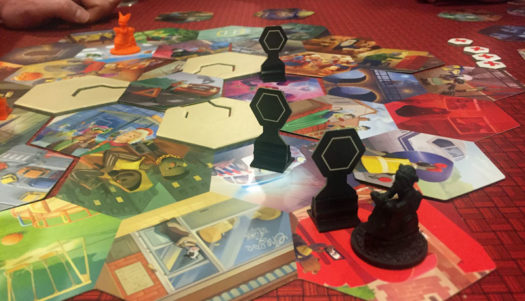
Shadows: Amsterdam reminds us of a mix of games that we love. For starters, it’s a bit like Mysterium where one person hands out visual clues to the other players to solve a mystery together. The artistic style of cards and locations also reminds us a lot of Dixit — which is all visual. And we’re also reminded of Codenames where players split into two teams and the clue giver tries to get their teammates to zero in on specific cards within a grid.
Yet, even though there are similar aspects to all those games we love, Shadows: Amsterdam stands very well on its own. And as such, it comes out as another game we really enjoy playing.
The last thing we’ll mention is the artwork. The style of imagery in the game says “family game” all over it. It definitely reminds us of Zootopia because of all the cute animals and colorful settings. It also has us zipping to different locations chasing down evidence (just like in Zootopia).
So if you’re looking for Zootopia the board game, this is the best you’ll find.
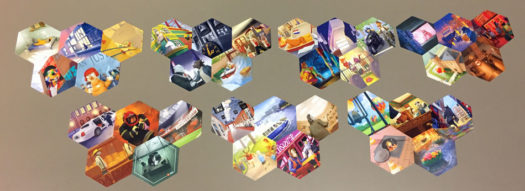
How does Shadows: Amsterdam score on our “Let’s Play Again” game meter?
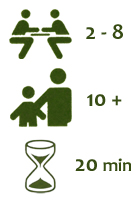 Shadows: Amsterdam gets high marks on our “let’s play again” game meter because of all the reasons mention above. The real time aspect of the game makes it feel like it whizzes by in a hurry and we’re left wanting to play again. Plus, everyone wants to take their turn as the clue giver, which leads to playing back-to-back games as well.
Shadows: Amsterdam gets high marks on our “let’s play again” game meter because of all the reasons mention above. The real time aspect of the game makes it feel like it whizzes by in a hurry and we’re left wanting to play again. Plus, everyone wants to take their turn as the clue giver, which leads to playing back-to-back games as well.
The beauty of playing multiple games in a row is that the board doesn’t change. Thus, players will get more familiar from game to game with the imagery in the board locations. The map tiles get switched out, so the target locations will change, but the game will flow a bit quicker even from play to play because of getting more familiar with the imagery.
All in all, Shadows: Amsterdam has been a very pleasant surprise. From not know much about the game when we first got it, to having a great time, it’s definitely a keeper!
We’d like to thank Asmodee for a review copy of Shadows: Amsterdam.



